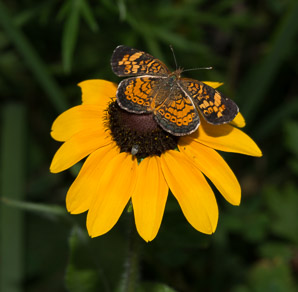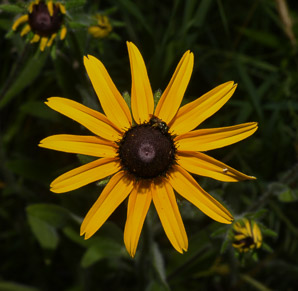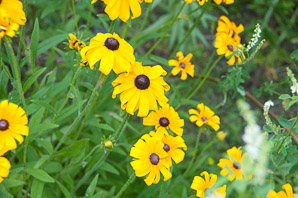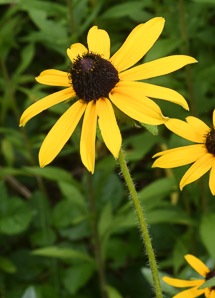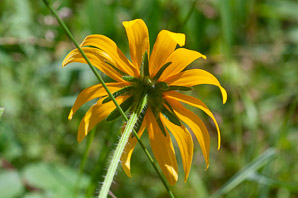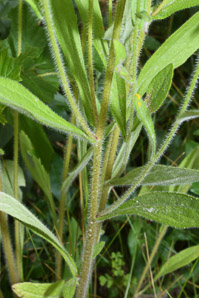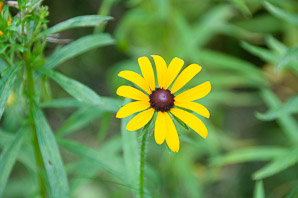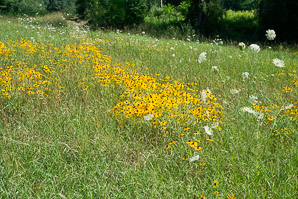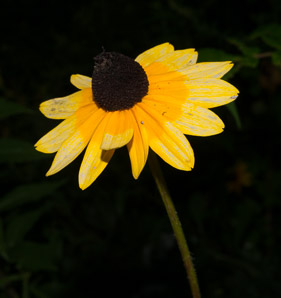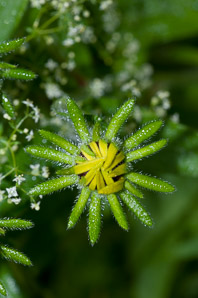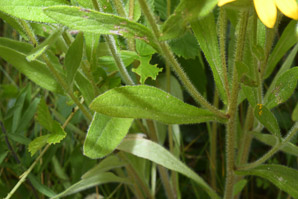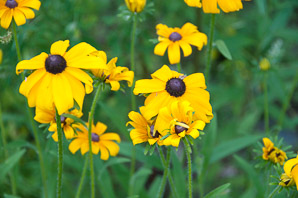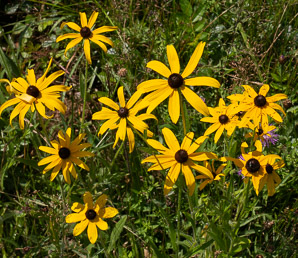
|
Rudbeckia hirta L. Black-eyed Susan
These cheerful North American natives brighten meadows wherever they crop up, which is practically everywhere. Perhaps this explains why they have so many common names. Black-eyed Susans are also popular with gardeners, and many cultivated varieties have been developed. Identification: Plants are up to 3′ (1 m) tall, but usually closer to half that height. The longest leaves are at the base, where they reach 4-7″ (10-18 cm). The lower leaves are diamond-shaped, with three conspicuous veins. Leaves dwindle in size further up the stems, becoming lance-shaped and covered with fuzzy hairs. Attractive yellow ray flowers up to 3″ (8 cm) in diameter appear atop hairy, rough-feeling stems. The centers are shaped a bit like a beehive, and composed of tiny dark brown or purplish disk flowers. Online References:
The Lady Bird Johnson Wildflower Center Plants for a Future, a resource and information centre for edible and otherwise useful plants The USDA Forest Service's Fire Effects Information Database Pearl crescent butterflies (Phyciodes tharos) like this one have a special affinity for these flowers. · 7/20/2013 · Wooden Bridge, East Pepperell, Massachusetts · ≈ 9 × 6″ (23 × 16 cm) 6/27/2016 · Nashua River Rail Trail, near Nashoba Hospital, Ayer, Massachusetts 6/27/2016 · Nashua River Rail Trail, near Nashoba Hospital, Ayer, Massachusetts 8/1/2009 · Gordon & Kathy’s, Prospect, Maine · ≈ 15 × 10″ (37 × 24 cm) 7/8/2016 · Dunstable Rural Land Trust, Dunstable, Massachusetts 7/11/2012 · Jeff Smith Trail, Pepperell, Massachusetts · ≈ 7 × 4½″ (17 × 11 cm)
Rudbeckia hirta description by Thomas H. Kent, last updated 17 Oct 2023. © FloraFinder.org. All rights reserved. |
8/14/2013 · Beaver Brook Assn Conservation Lands, Rte. 130, Hollis, New Hampshire 7/8/2016 · Dunstable Rural Land Trust, Dunstable, Massachusetts 8/1/2009 · Gordon & Kathy’s, Prospect, Maine · ≈ 5 × 3½″ (13 × 8.8 cm) 7/24/2013 · Beaver Brook Assn Conservation Lands, Rte. 130, Hollis, New Hampshire 10/18/2008 · Kimball’s Ice Cream, Westford, Massachusetts 8/14/2013 · Beaver Brook Assn Conservation Lands, Rte. 130, Hollis, New Hampshire 6/11/2010 · Nashua River Rail Trail, Groton Center, Groton, Massachusetts · ≈ 3 × 4½″ (7.5 × 11 cm) 6/30/2010 · Nashua River Rail Trail, Groton Center, Groton, Massachusetts · ≈ 9 × 6″ (23 × 15 cm) 7/8/2016 · Dunstable Rural Land Trust, Dunstable, Massachusetts 8/1/2009 · Gordon & Kathy’s, Prospect, Maine · ≈ 9 × 6″ (22 × 15 cm) 7/20/2023 · Curtis Farm Preserve, Harpswell, Maine
|
